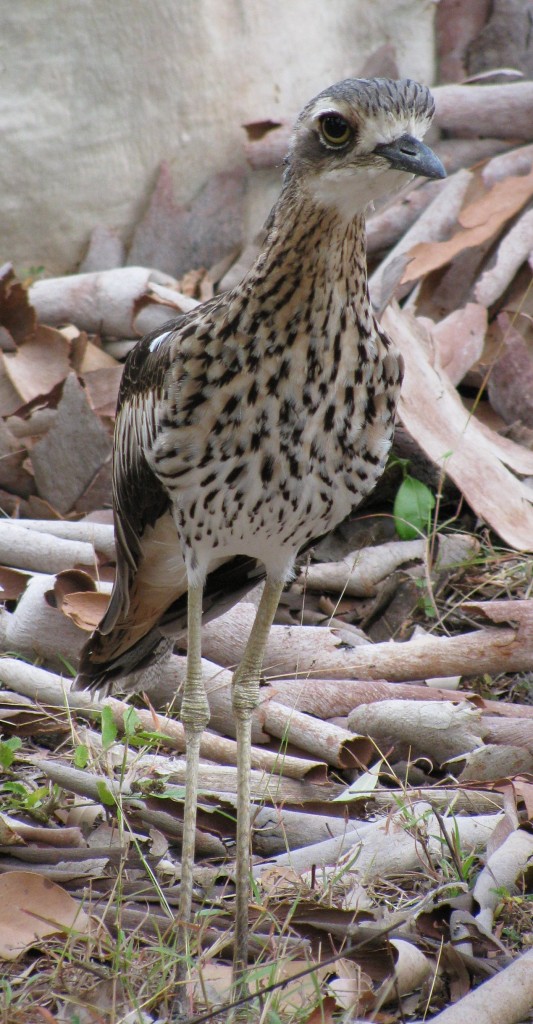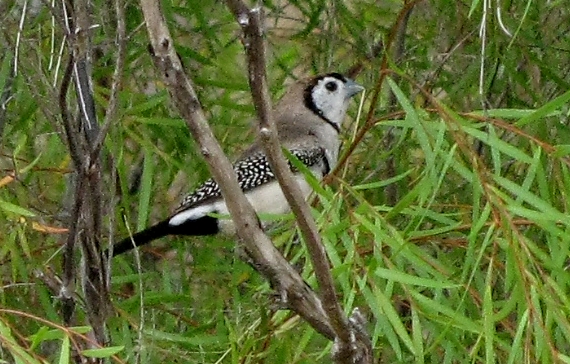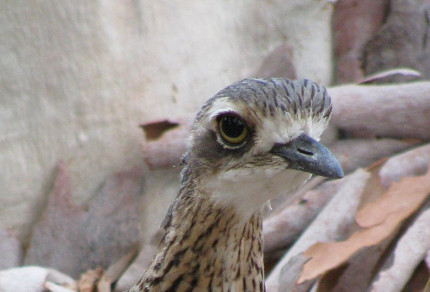Today, for the first time, I became frustrated with rainbow lorikeets. There were simply too many racing across the sky above Townsville. They flocked into flowering gums and paperbarks, their shrill squawks ripping holes in my sound space and overwhelming the calls of less boisterous birds. As I cycled to JCU, I figured the lorikeets were the avian equivalent of the squadrons of RAAF jet fighters that have been screaming over Townsville during the past week or so. Perhaps the birds don’t equate with the fighters’ decibel level, but their swift-flying flocks and ear-shattering screeches nonetheless bear a distinct similarity.
I found a measure of peace in the subdued beauty of a spotted turtle-dove whose pink-brown colours blended with the clays of the ditch it was in, its white-spotted nape standing out like a gaily-worn scarf. An olive-backed oriole sang a lilting, oft-repeated “orry-orry-ol,” and in the trees along Goondaloo Creek on the James Cook University campus, the air was filled with the calls of grey fantails, white-bellied and black-faced cuckoo-shrikes, yellow honeyeaters, and rainbow bee-eaters that dove from dead-branch perches and returned to them to bash off the wings of their butterfly prey before devouring them. (And yes, there were rainbow lorikeets.)

Bush Stone-curlew (© Magi Nams)
I had come to JCU hoping to photograph the batik-like beauty of the pale-headed rosellas I’d seen on campus on previous visits. The rosellas, however, revealed themselves in only quick flashes of movement within dense foliage, offering no opportunities to capture their portraits. Instead, it was a bush stone-curlew that provided unexpected loveliness. I normally see stone-curlews as hunching shapes resting on the Townsville Golf Course, or hear their crazy wails in the night. But this curlew stood before a poplar gum surrounded by tatters of bark, the subtle peach and grey-white shades of which matched the background colour of the stone-curlew’s neck, belly and undertail feathers to perfection. Once again I told myself that beauty is where you find it, not where you expect to find it.

Double-barred Finch Carrying Dead Grass for its Nest Construction at JCU (© Magi Nams)
Today’s birds: masked lapwings, magpie-larks, peaceful doves, rainbow lorikeets, pied butcherbird, laughing kookaburras, blue-faced honeyeaters, great bowerbirds, little friarbirds, welcome swallows, brown honeyeaters, yellow honeyeaters, rainbow bee-eaters, Australian magpies, anhinga, little egret, intermediate egret, great egret, white-faced heron, little pied cormorant, Brahminy kite, spotted turtle-dove, mynas, olive-backed oriole, white-gaped honeyeater, white-bellied cuckoo-shrikes, black-faced cuckoo-shrikes, willie wagtail, grey fantails, spangled drongo, red-tailed black-cockatoo, little corellas, sulphur-crested cockatoos, Australian raven, Australian brush-turkey, noisy friarbird, pale-headed rosellas, double-barred finch, bush stone-curlews, straw-necked ibises, Torresian crow.


